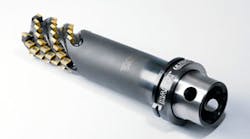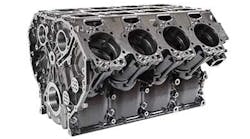For their part, machine tool builders have improved stiffness and damping on spindles and machine structures to minimize vibration that will degrade part quality and tool life. These are advancements for productivity, but the spindle connection remains a weak point in the architecture of production.
Tooling experts at Kennametal addressed this with the KM™ quick-change system (ISO 26622), and now the group is introducing an advancement for that spindle connection, KM4X™. While some systems may transmit high levels of torque, cutting forces also generate bending moments that will exceed the limits of an interface before torque limits are exceeded. The combination of the KM4X system’s high clamping force and controlled interference levels lead to a solid connection, high stiffness, and restrained bending moment for greatly improved performance in titanium machining.
Kennametal maintains that its KM4X design results in three times the bending moment resistance that other tool systems offer, meaning that shops can use their high-performance machining centers to increase speeds and feeds in difficult machining applications, and thereby take full advantage the machine too. Even retrofitting the spindle connection to a current installation will increase its machining productivity without the capital investment required for a new equipment installation.
The “interface” between a tool and the spindle interface endures high loads during machining, and still it must maintain its rigidity. “In most cases it will determine how much material can be removed on a given operation until tool deflection is too high or the onset of chatter is reached,” according to Kennametal.
Several types of spindle connection have been developed or optimized, but the 7/24 ISO taper standard is recognized as having the greatest cost benefits for machine shops. It’s widely used though there are limits to its accuracy and speed.
The emergence of face contact represented an improvement over the standard 7/24 taper. Combining face contact with the 7/24 solid taper provides higher accuracy in the Z-axis, but the loss in stiffness at higher speeds or high side loads constitute a disadvantage. Most tools are solid, and the spindles have relatively low clamping force. Radial interference must be minimized, so connection stiffness is limited. Thus, the tolerances required to achieve consistent face contact are very tight, increasing manufacturing costs.
Kennametal introduced the KV system more than 25 years ago. It was a shortened version of CV tooling with a three-ball mechanism acting on a conical surface of a bore. Later versions were designed with face contact. In 1985, Kennametal and Krupp WIDIA began to develop the KM universal quick-change system (recently standardized as ISO 26622.) The polygonal taper-face connection known as PSC (ISO 26623) and the HSK system (ISO 121) followed.
When machining titanium or other very tough, cutting speeds are relatively low due to thermal effects on cutting tools. Machine tool builders have improved stiffness and damping on spindles and machine structures lately, and spindles have been designed with high torque capability at low rotational speeds.
The spindle connection must provide torque and limited bending capacity that is compatible with machine-tool specifications and high-productivity requirements. In end-milling applications, where projection lengths are typically greater, the spindle connection’s bending capacity is the limiting factor.
Kennametal offers the following as an example: An indexable helical cutter with 250 mm (9.84 in.) projection from spindle face, 80 mm (3.15 in.) in diameter, generates 4,620 Nm (3,407.5 ft. lbs.) of bending moment, and less than 900 Nm (663.8 ft. lbs.) of torque.
The most critical parameters of a taper-face spindle connection are the clamping force and radial interference, according to Kennametal. Maximizing clamping force and selecting appropriate values of interference will improve the rigidity of the connection.







